 It’s becoming quite obvious that drones and police work go hand-in-hand (rotor-in-hand?) — with uses ranging from election surveillance in India to drug-smuggling investigations in China. UAVs may even replace the traditional notion of “riot squads” in the coming days.
It’s becoming quite obvious that drones and police work go hand-in-hand (rotor-in-hand?) — with uses ranging from election surveillance in India to drug-smuggling investigations in China. UAVs may even replace the traditional notion of “riot squads” in the coming days.
According to a recent report by arms-control researcher Michael Crowley, the future of public security drones may lie in realm of non-lethal weaponization.
It’s already possible to equip a drone with tear gas dispersal systems and Crowley points out that the conversation about melding UAV tech with crowd-control devices dates back to at least 2012 when a sheriff’s official in Montgomery County. Texas told the media that police were “considering using rubber bullets and tear gas on its drone,” adding that “those are things that law enforcement utilizes day in and day out and in certain situations it might be advantageous to have this type of system on the UAV.”
Several manufacturers, such as Vanguard Defense Industries’ ShadowHawk – described as a tactical UAV with three-hour flight-time capability and 35km range – offers law enforcement “less-lethal/lethal options including single or multiple shot 37mm/40mm grenade launcher, 12g shotgun, XREP Taser [electroshock projectile]”.
Such deadly capabilities worry many civil-liberties experts. In a recent interview with Inverse, ACLU staff attorney Nathan Wessler states:
“State and local law enforcement is able to get access to these devices in near-complete secrecy and use them secretly for years without appropriate oversight because the public, and the courts, and the legislatures are none-the-wiser. When finally the public learns what’s going on, and there starts to be laws and court decisions controlling the technology, it’s already too late.”
Another possible consequence of unleashing tear gas or deadlier firepower from the air is a lack of accountability should police actually kill a suspect or innocent bystander with a drone. In many recent cases of excessive violence use by police, bystanders have been instrumental in securing justice for victims by filming police violence – a futile gesture when the assailant is an anonymous quadcopter.
Crowley points out that delivering tear gas or other non-lethal weaponry by drones or other unmanned devices could open up a Pandora’s Box of negative implications.
“Inadequate regulation of such “remote control” means of delivery has potentially serious consequences, including … employment of inappropriate [remote] means of delivery in law enforcement — potentially resulting in the serious injury or death of bystanders as well as targeted individuals or groups,” he said.
Jason is a longstanding contributor to DroneLife with an avid interest in all things tech. He focuses on anti-drone technologies and the public safety sector; police, fire, and search and rescue.
Beginning his career as a journalist in 1996, Jason has since written and edited thousands of engaging news articles, blog posts, press releases and online content.
Email Jason
TWITTER:@JasonPReagan
Subscribe to DroneLife here.







Leave a Reply